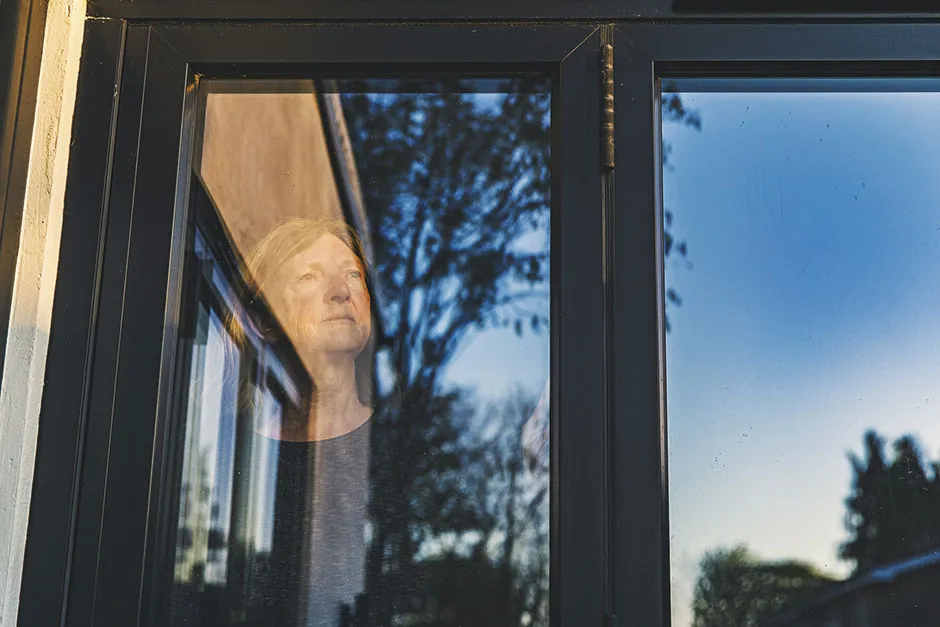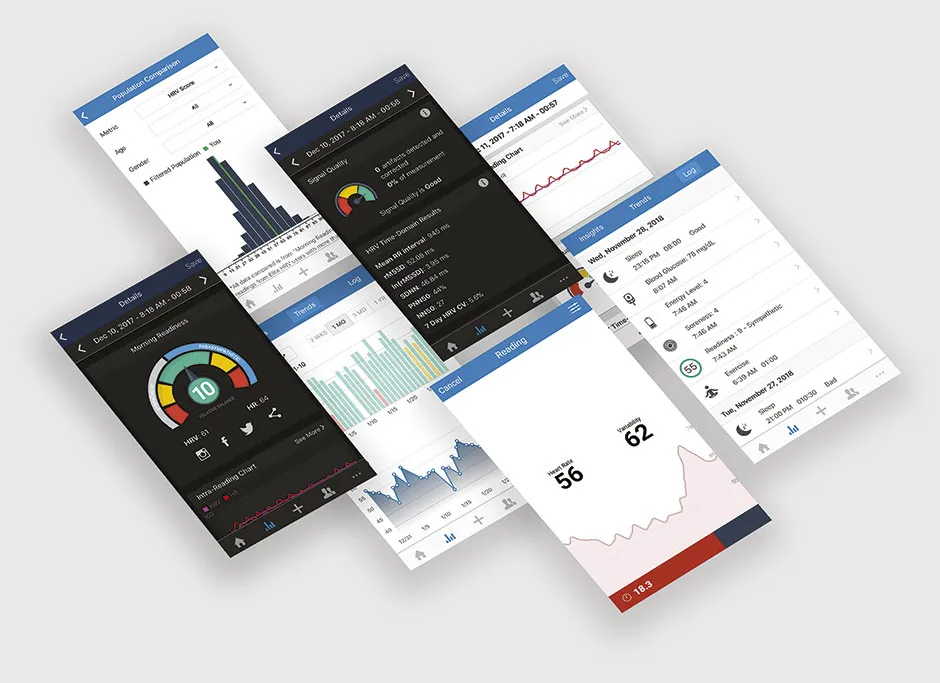Before COVID-19, loneliness was considered a national epidemic, and as bad for you as smoking 15 cigarettes a day. But by the middle of June 2020, social isolation had become the ‘new normal’ for more of us, with 7.4 million British people having experienced ‘lockdown loneliness’, according to the Office for National Statistics.
The knock-on effects that stress and loneliness could be having on our physical health are potentially vast, although they can be hard to spot when we’re in the thick of challenging times. A panic attack is relatively easy to identify, but the slow and steady creep of rising blood pressure or inflammation is less obvious.
Step forward, a little-known health marker called heart rate variability (HRV). HRV is a measure of the degree of variation in time between heartbeats. Greater variation means we’re in a good place – resilient, in control of our emotions and ready for anything. Lower variation implies we need to prioritise self-care.
This stress barometer of sorts can offer a window into the extent to which our mental health is manifesting in our bodies, and help motivate us to minimise our stress levels. HRV monitoring is increasingly offered through wearable devices, and understanding why it is relevant reveals some fascinating pathways between mind and body.
Read more about stress:
Let’s go back and think about loneliness again. We consider loneliness to be a feeling, rather than a disease, but as social animals, the safety we sense when we are among friends and loved ones is crucial in regulating the body’s autonomic nervous system (ANS). In turn, the ANS regulates involuntary bodily functions such as breathing, heart rate, blood pressure and digestion.
Chronic stress and loneliness can cause an imbalance in the ANS, leading us to spend too much time in so-called fight-or-flight mode – something we hear an awful lot about in high-stress modern life. It can be life-saving in appropriate emergencies, but it is not a healthy state in which to linger. It puts a strain on the mind and body, so we spend too little time resting and recuperating, and HRV decreases.
Healthy body, healthy mind
Zooming in on our mind/body connection a little closer, information on what we sense and how we feel emotionally is constantly processed in a primitive region of our brains called the hypothalamus, which sends signals to the rest of the body through the ANS to intensify or relax bodily functions as needed.
Fight-or-flight mode is governed by a wing of the ANS called the sympathetic nervous system. When this is activated, our pupils dilate – all the better to see an approaching threat. Digestion slows, while blood glucose is boosted in preparation to fight or flee.
The opposing wing of the ANS is the parasympathetic nervous system, which governs ‘rest and digest’ and ‘feed and breed’ activities such as salivation, urination and sexual arousal.
All of these reflexes are part of our homeostasis system, which keeps our bodies stable, and ready to respond to changing environments. At rest, we should sit near the middle of the spectrum of sympathetic and parasympathetic activation.
This healthy balance means we are at our most resilient and able to cope with stressors and changing circumstances, and is reflected in our HRV. Or as Amelia Stanton, a clinical research fellow in psychology at Harvard Medical School, puts it: “HRV tells you how the body is regulating its responses to external changes.”

Over the last five years, we’ve seen fitness enthusiasts and couch potatoes alike cheerfully gamify their health stats, counting steps or logging lap records on their fitness apps. HRV fits into this picture perfectly. If you learn how to pimp your HRV scores, then it could help you become more resilient.
Part of that might be identifying what causes you emotional stress and finding practical ways around those issues, from avoidance to better planning to seeking support from loved ones. Apps such as Elite HRV, and the accompanying app for the sleep- and activity-tracking ring, Oura, encourage users to add customised tags – anything from exercise, sleep and meditation, to alcohol consumption, dietary changes and work deadlines – to each day’s HRV reading, in the hope that over time, patterns will start to emerge.
Low HRV scores also serve as a warning to take things easy when your resilience is lower, whether it’s due to stress, cyclical hormonal fluctuations, illness or jet lag.
Are HRV devices any use?
Interpretations of the data used for HRV readings vary between practitioners and apps. HRV data is complex, which, coupled with a fair amount of debate over best practice and the efficacy of unregulated consumer products, is presumably why HRV has remained out of the public consciousness up to now.
Dr Stephen Porges, director of the Trauma Research Center in the Kinsey Institute at Indiana University, has been working with HRV and emotional resilience since the 1960s.
He was initially against consumer products being offered for HRV tracking at home, but he now concedes that, while the data from consumer devices are far from a clinical standard, such products “are helpful to people because they get them aware of their own body”. When we’re dealing with trauma and behavioural disorders, “people tend to be numb to their own bodies, and this gets them back into their body. So however they’re doing it, it’s helpful, and it’s doing no harm,” he says.
Read more about loneliness:
- Hikikomori: identifying extreme social isolation around the globe
- The effects of loneliness – and what's being done
When I speak with Dr Marek Malik, emeritus professor of cardiac electrophysiology at Imperial College London, who was on the committee that published the first international standards for measuring HRV in 1996, he is furious.
“Some of these gadgets are inappropriate and useless,” hesays. “You need to have a controlled electrocardiogram. And even gadgets that would be appropriate technically, simply are unsuitable if they are used in the wrong environment and in the wrong conditions.” He points out that HRV is affected by so many things that it’s only relevant if taken in expertly controlled conditions.
Dr Paul Lehrer, on the other hand, who recently retired from Rutgers University in New Jersey, has spent most of his career studying the use of breathing to increase HRV to treat everything from anxiety to chronic pain. He says that most devices are adequate for this work, apart from finger pulse detectors on smartphones.
So it seems that if you want to track your HRV you must be mindful that it isn’t gospel – in the same way that 10,000 steps doesn’t necessarily equate to a healthy lifestyle.
Resonant breathing
The type of breathing that increases HRV is known as resonant breathing, coherent breathing, or HRV biofeedback. “There are various rhythms in heart rate that each correspond to one of the body’s control systems,” explains Lehrer.
“And two of these are involved in HRV biofeedback. One of them is called respiratory sinus arrhythmia – a rhythm that goes along with breathing and is controlled by the vagus nerve, which is the major parasympathetic nerve.” So if you’re boosting that rhythm, “you’re essentially stimulating the vagus nerve – the system that helps to relax you.”
The other is called the baroreflex, which regulates blood pressure. “The baroreflex is controlled by the sympathetic nervous system,” says Lehrer. “But it has connections in the brain that connect to the structures that generate and control emotion.” So during resonant breathing, he says, “you’re stimulating systems that control emotion, essentially.”
Resonant breathing is about synchronising those two heart rhythms. You slow your natural breathing rate of about 15 breaths per minute (respiratory sinus arrhythmia) to about six times a minute (baroreflex).

To learn resonant breathing, you need a heart rate monitor connected to an HRV app, such as Elite HRV or Coherence Trainer, which shows increasing circles for inhaling and decreasing for exhaling and will let you know how well you’re doing in real time.
“It’s a godsend,” says Porges. “It’s a magic gift because we can access it through voluntary behaviour, and it has such profound effects on our neurophysiology.” In fact he calls it a type of “neural exercise”. Helpfully, in times of social distancing, we can do it on our own.
Slowing your breathing to any extent will have an effect, but it won’t be as profound as with resonant breathing. This is because with resonant breathing, you are stimulating the blood-pressure control reflexes and the respiratory control reflexes that help control gas exchange, says Lehrer.
As well as getting better athletic performance, exercise tolerance and oxygen control, you also get improved emotional control for people who are stressed or anxious.
Lehrer and his colleagues have shown that resonant breathing helps people who are suffering with emphysema, asthma, depression and related unexplained chronic pain. It is being used to treat PTSD in US veterans, and can even reduce cravings associated with various addictions. Lehrer usually recommends 20 minutes of resonant breathing twice a day, which he says will lead to “big changes in heart rate variability”.
Read more about the heart:
- Fitbit investigates whether wearables can diagnose heart conditions
- Heart attacks: the discoveries bringing an end to one of the UK's biggest killers
Elsewhere, Dr David Shearer, professor of elite performance psychology at the University of South Wales, used more accessible versions of HRV biofeedback, involving just five minutes of practice per day, and still got results. He uses HRV biofeedback as a tool for teaching emotional awareness and control, to help overcome those moments when athletes crumble under pressure, known as choking.
“As sympathetic nervous system arousal increases under pressure, it reaches a point where it causes cognitive interference, to such an extent that it impedes performance,” he says. “This can manifest itself in many ways, but might include high levels of anxiety, hyper-vigilance, poor decision making, and a lack of emotional awareness. Breathing at resonant frequency is a bit like hitting the reset button.”
He says that this effect can be replicated in everyday life. Who hasn’t found themselves suddenly tongue-tied in an important meeting?
It’s a skill that takes practice to master, though, and doing the breathing doesn’t mean we should let other healthy choices slip. “The best training strategy treats the whole person,” says Dr Fredric Shaffer, president-elect of the Association for Applied Psychophysiology and Biofeedback. “HRV biofeedback is only one piece of the puzzle.”
- This article first appeared inissue 355ofBBC Science Focus Magazine–find out how to subscribe here
